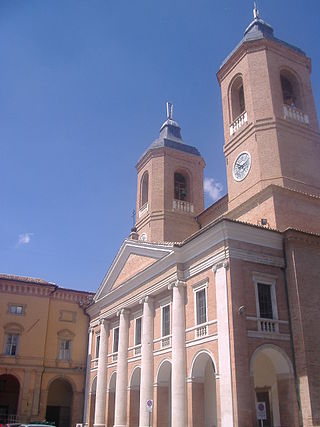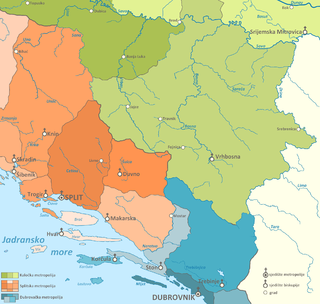
The Italian Catholic diocese of Narni , in central Italy, was suppressed in 1907, becoming part of the diocese of Terni. [1] [2]

The Italian Catholic diocese of Narni , in central Italy, was suppressed in 1907, becoming part of the diocese of Terni. [1] [2]
Narni is the ancient Nequinum of the Sabines, called Narnia by the Romans. Liutprand captured the town in 726, but Pope Zacharias persuaded him to restore it to the Duchy of Rome in 742, after which it remained under pontifical rule.
Narni venerates as its first bishop the martyr Juvenalis, who died in the second half of the fourth century; Maximus, who was bishop in 425, was succeeded by his two sons Hercules and Pancratius. Gregory the Great refers to the bishop Cassius, who died in 558; the same pontiff wrote a letter to the bishop Projectinus which shows that, at Narni, at that time, there were still pagans to be converted.
Bishop John (940) was succeeded by his son, who became Pope John XIII; among other bishops were: William, a Franciscan, whom Pope Urban V employed against the Fraticelli (1367); and Raimondo Castelli (1656), founder of the seminary.
From 1198 to 1214, Narni was in rebellion against Pope Innocent III, who temporarily suppressed its episcopal see. The churches of this city contain many paintings of the ancient Umbrian school.
United 12 April 1907 with the Diocese of Terni to form the Diocese of Terni e Narni
![]() This article incorporates text from a publication now in the public domain : Herbermann, Charles, ed. (1913). "Narni and Terni". Catholic Encyclopedia . New York: Robert Appleton Company.
This article incorporates text from a publication now in the public domain : Herbermann, Charles, ed. (1913). "Narni and Terni". Catholic Encyclopedia . New York: Robert Appleton Company.

The Diocese of Kotor is a Latin Church ecclesiastical jurisdiction or diocese of the Catholic Church in the Bay of Kotor and Municipality of Budva area in Montenegro. It is centered in the city of Kotor (Cattaro). It was erected as a diocese in the 10th century.

The Diocese of Hvar is a Latin diocese of the Catholic Church in the Dalmatian islands in Croatia.

The Italian Archdiocese of Camerino-San Severino Marche is a Latin diocese of the Catholic Church seated in Camerino, a city in the Province of Macerata, in the central Italian Marche region, in the Apennines. It is a suffragan of the Archdiocese of Fermo.

The Italian Catholic diocese of Monopoli, in the province of Bari, existed from the eleventh century to 1986. In that year it was united into the diocese of Conversano-Monopoli.

The Archdiocese of Mérida–Badajoz is a Latin Church ecclesiastical territory of the Catholic Church in Spain, created in 1255. Until 1994, it was known as the Diocese of Badajoz.
The diocese of Nepi-Sutri was a Roman Catholic ecclesiastical territory in central Italy, created in 1435 by unifying the diocese of Nepi and the diocese of Sutri. It existed until 1986, when it was united into the current diocese of Cività Castellana.

The Diocese of Terni-Narni-Amelia is a Latin Church ecclesiastical territory or diocese of the Catholic Church in Umbria, central Italy. It was created in 1983, when the Diocese of Amelia was united with the Diocese of Terni and Narni. The latter had been in turn created in 1907, when the Diocese of Narni was united to the historical Diocese of Terni. The diocese is immediately exempt to the Holy See, not part of any ecclesiastical province.

The Diocese of Mallorca (Latin: Dioecesis Maioricensis is a Latin Church diocese of the Catholic Church located in the city of Palma, Majorca in the ecclesiastical province of Valencia in Spain.
The Diocese of Santorini is a Latin Church diocese of the Catholic Church located in the city of Santorini in the ecclesiastical province of Naxos, Andros, Tinos and Mykonos in Greece.
The Italian Catholic Diocese of Amelia, existed from the fifth century until 1983. In that year it was united into the new diocese of Terni, Narni, e Amelia. It was a suffragan of the archdiocese of Spoleto.
The former Italian Catholic Diocese of Città della Pieve, in Umbria, existed until 1986. In that year it was united into the Archdiocese of Perugia-Città della Pieve.
The former Italian Catholic Diocese of Sant'Angelo dei Lombardi-Bisaccia, in the Province of Avellino, Southern Italy, existed until 1921, when it was united into the Archdiocese of Conza-Campagna to form the Archdiocese of Conza-Sant'Angelo dei Lombardi-Bisaccia.
The former Italian Catholic Diocese of Urbania and Sant’Angelo in Vado, in the Marche, existed from 1636 to 1986. In the latter year, it was united into the Archdiocese of Urbino, to form the Archdiocese of Urbino-Urbania-Sant'Angelo in Vado.
The Italian Catholic diocese of Bitonto, in Apulia, had a short independent existence from 1982 to 1986. In the latter year it was united into the Archdiocese of Bari, forming the Archdiocese of Bari-Bitonto. Before 1982, it had existed since the 9th century until being united into the diocese of Ruvo e Bitonto in 1818.
Paolo Emilio Cesi (1481–1537) was an Italian Roman Catholic cardinal.
The Diocese of Isola was a Roman Catholic diocese in Italy, located in Isola di Capo Rizzuto, Crotone, Reggio Calabria in the ecclesiastical province of Santa Severina.

The Diocese of Ston was a Roman Catholic diocese in Croatia, located in the city of Stagno. In 1828 it was suppressed to the Archdiocese of Dubrovnik.
Raimondo Castelli was a Roman Catholic prelate who served as Bishop of Narni (1656–1670).
The Diocese of Umbriatico was a Roman Catholic diocese located in the town of Umbriatico in the province of Crotone in southern Italian region of Calabria. In 1818, it was suppressed with the bull De utiliori of Pope Pius VII, and incorporated in the diocese of Cariati.
Bartolomeo Cesi was a Roman Catholic prelate who served as Bishop of Narni (1524–1537).